The Bulldozer Review: AMD FX-8150 Tested
by Anand Lal Shimpi on October 12, 2011 1:27 AM ESTGaming Performance
AMD clearly states in its reviewer's guide that CPU bound gaming performance isn't going to be a strong point of the FX architecture, likely due to its poor single threaded performance. However it is useful to look at both CPU and GPU bound scenarios to paint an accurate picture of how well a CPU handles game workloads, as well as what sort of performance you can expect in present day titles.
Civilization V
Civ V's lateGameView benchmark presents us with two separate scores: average frame rate for the entire test as well as a no-render score that only looks at CPU performance.
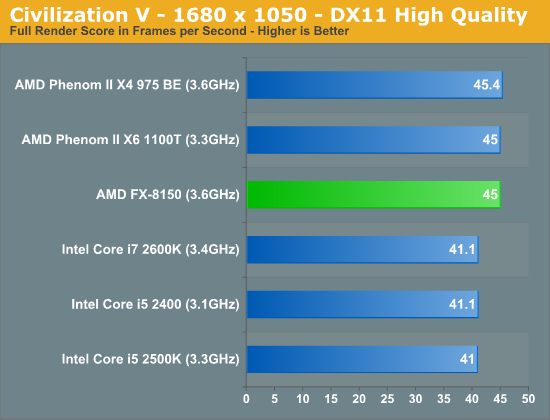
While we're GPU bound in the full render score, AMD's platform appears to have a bit of an advantage here. We've seen this in the past where one platform will hold an advantage over another in a GPU bound scenario and it's always tough to explain. Within each family however there is no advantage to a faster CPU, everything is just GPU bound.
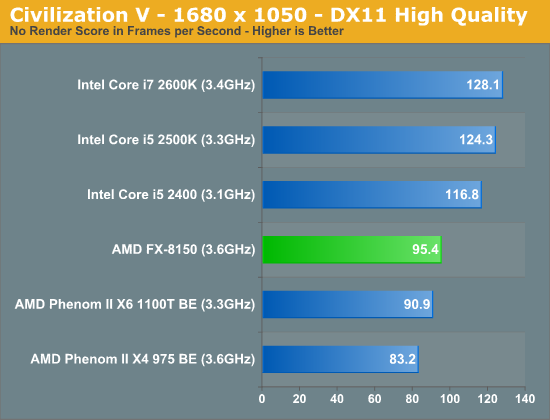
Looking at the no render score, the CPU standings are pretty much as we'd expect. The FX-8150 is thankfully a bit faster than its predecessors, but it still falls behind Sandy Bridge.
Crysis: Warhead
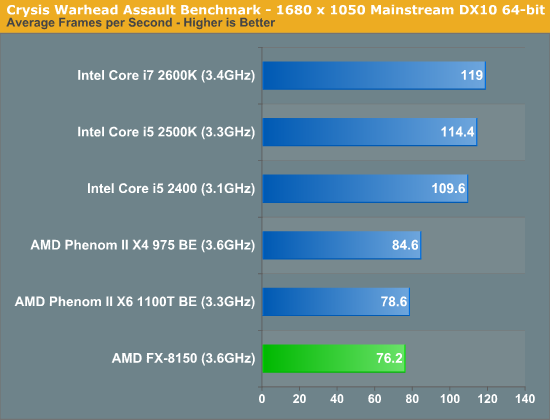
In CPU bound environments in Crysis Warhead, the FX-8150 is actually slower than the old Phenom II. Sandy Bridge continues to be far ahead.
Dawn of War II
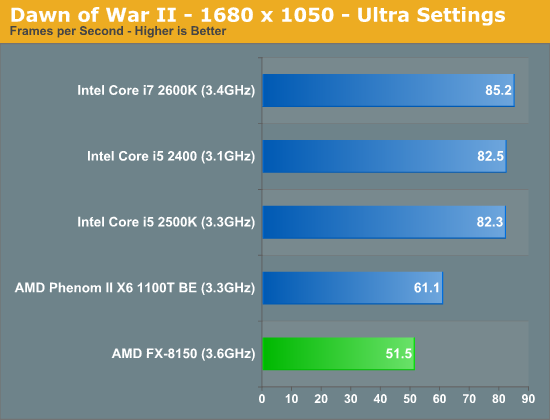
We see similar results under Dawn of War II. Lightly threaded performance is simply not a strength of AMD's FX series, and as a result even the old Phenom II X6 pulls ahead.
DiRT 3
We ran two DiRT 3 benchmarks to get an idea for CPU bound and GPU bound performance. First the CPU bound settings:
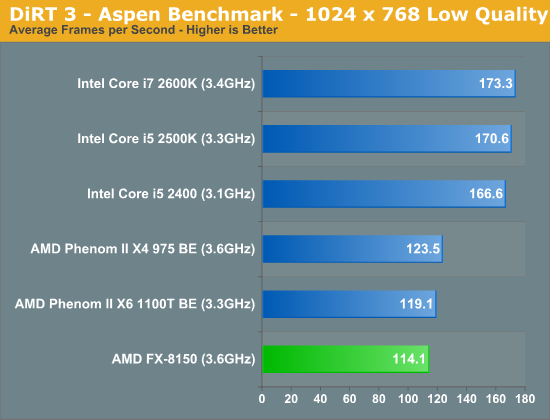
The FX-8150 doesn't do so well here, again falling behind the Phenom IIs. Under more real world GPU bound settings however, Bulldozer looks just fine:
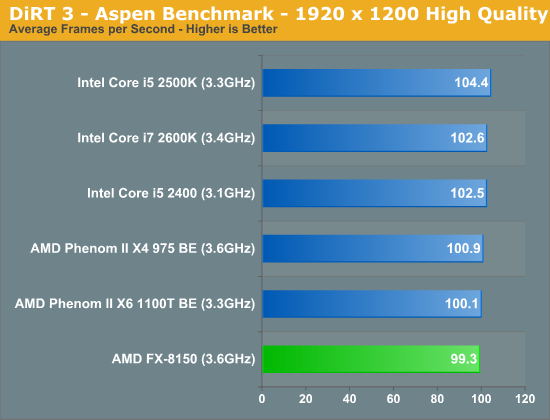
Dragon Age
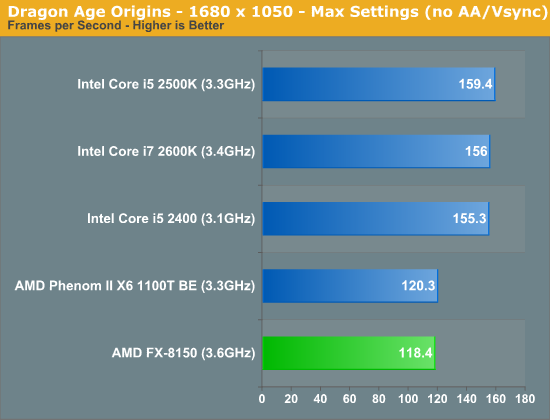
Dragon Age is another CPU bound title, here the FX-8150 falls behind once again.
Metro 2033
Metro 2033 is pretty rough even at lower resolutions, but with more of a GPU bottleneck the FX-8150 equals the performance of the 2500K:
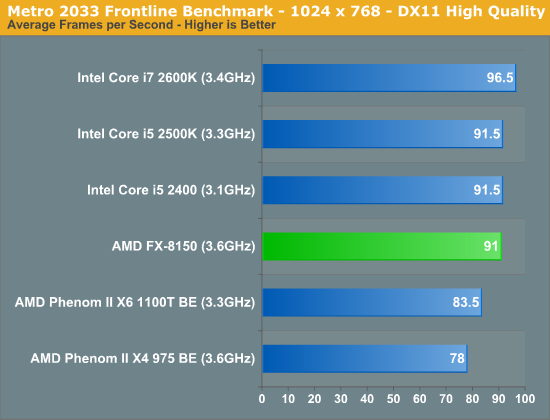
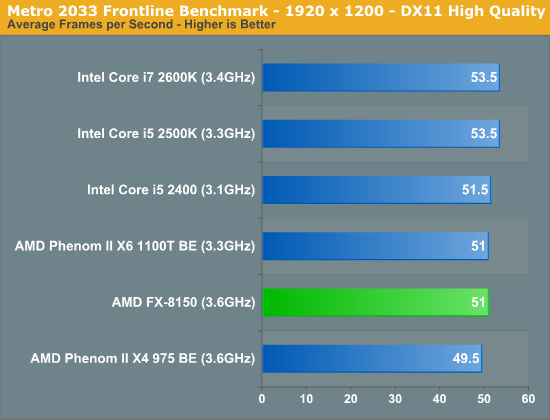
Rage vt_benchmark
While id's long awaited Rage title doesn't exactly have the best benchmarking abilities, there is one unique aspect of the game that we can test: Megatexture. Megatexture works by dynamically taking texture data from disk and constructing texture tiles for the engine to use, a major component for allowing id's developers to uniquely texture the game world. However because of the heavy use of unique textures (id says the original game assets are over 1TB), id needed to get creative on compressing the game's textures to make them fit within the roughly 20GB the game was allotted.
The result is that Rage doesn't store textures in a GPU-usable format such as DXTC/S3TC, instead storing them in an even more compressed format (JPEG XR) as S3TC maxes out at a 6:1 compression ratio. As a consequence whenever you load a texture, Rage needs to transcode the texture from its storage codec to S3TC on the fly. This is a constant process throughout the entire game and this transcoding is a significant burden on the CPU.
The Benchmark: vt_benchmark flushes the transcoded texture cache and then times how long it takes to transcode all the textures needed for the current scene, from 1 thread to X threads. Thus when you run vt_benchmark 8, for example, it will benchmark from 1 to 8 threads (the default appears to depend on the CPU you have). Since transcoding is done by the CPU this is a pure CPU benchmark. I present the best case transcode time at the maximum number of concurrent threads each CPU can handle:
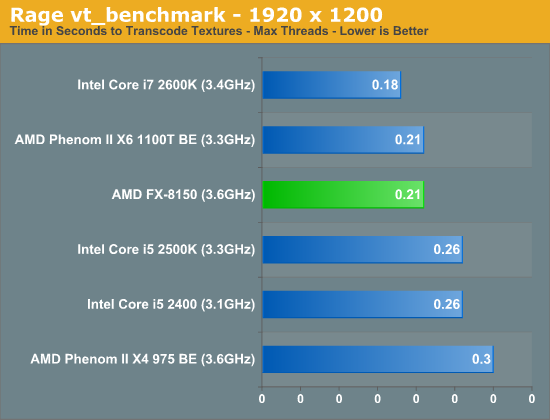
The FX-8150 does very well here, but so does the Phenom II X6 1100T. Both are faster than Intel's 2500K, but not quite as good as the 2600K. If you want to see how performance scales with thread count, check out the chart below:
Starcraft 2

Starcraft 2 has traditionally done very well on Intel architectures and Bulldozer is no exception to that rule.
World of Warcraft
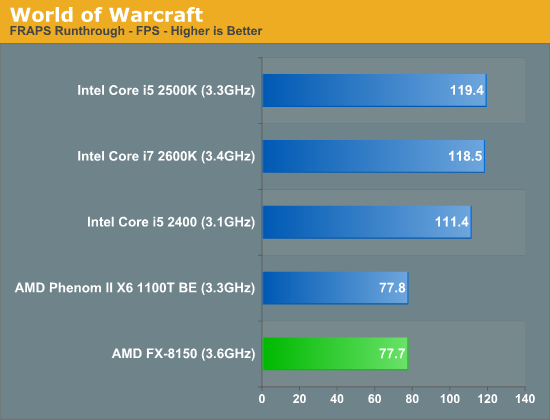


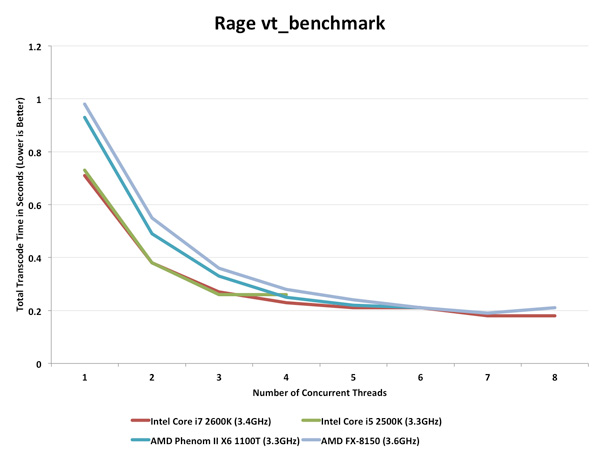








430 Comments
View All Comments
Mishera - Monday, October 17, 2011 - link
Good points TekDemon. But I'll add that from what I understand, the GPU might be capable of processing huge amounts of graphic information, but might have to wait for the CPU to process certain information before it's able to continue, hence some games going only so high in graphic tests no matter what kind of GPU is put in.Like he said, buying a good CPU will last longer than spending that money on a really good GPU. I personally try to build a balanced system since by the time I upgrade it's a pretty big jump on all ends.
Snorkels - Wednesday, October 12, 2011 - link
This and other benchmark tests are BOGUS. You are comparing apples to oranges. LiarMarks..This test shows non-optimized code for AMD vs optimized code for the Intel CPU.
It does not show the actual performance of the Bulldozer CPU.
Most software companies compile their software using Intels compiler, which creates crappy and unefficient codepaths for AMD processors.
Compile with Open64 compiler and you get a totally different result.
actionjksn - Wednesday, October 12, 2011 - link
@Snorkels If most software company's are using an Intel compiler, why would you want an AMD processor that can't utilize it properly.g101 - Wednesday, October 12, 2011 - link
Well, I'm happy that gamer children cannot understand the point of this architecture. You obviously have no concept of the architectural advantages, since it's not designed for game-playing children or completely unoptimized synthetic benchmarks.Bulldozer optimized and future-proofed for professional software, rather than entertainment software for children.
AssBall - Wednesday, October 12, 2011 - link
"obviously have no concept of the architectural advantages"Enlighten us then, oh wise one.
guyjones - Sunday, October 16, 2011 - link
Who exactly is the child here? Your infantile comment conveniently ignores the fact that AMD has made gigantic marketing pushes that are clearly directed at the gamer community, not to mention gaming-related sponsorship activities and marketing tie-ins. So, on the contrary, the company has made very visible and consciously-directed efforts to appeal to gamers with its products. It is totally unreasonable to now posit that BD is not directed at least in part toward that market segment.Will Robinson - Wednesday, October 12, 2011 - link
FailDozer....pretty limp performance numbers.Intel still rules.
etrigan420 - Wednesday, October 12, 2011 - link
What an unfortunate series of events...maybe my e8400 will hold out a little longer...Malih - Wednesday, October 12, 2011 - link
before reading (and i've read all other review sites -and disappointed at AMD-, just dying to see your view on the matter) thanks for the review as alwaysxorbit - Wednesday, October 12, 2011 - link
You are not measuring "branch prediction" performance. You are measuring misspeculation penalty (due to longer pipeline or other reasons). Nothing can "predict" random data-dependent branches.